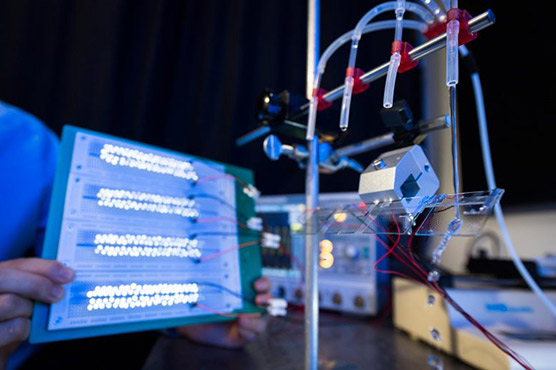Scientists develop droplet-based electricity generator that can 100 LED bulbs per rain drop

The latest approach shows there might be a way to get power from rain showers efficiently.
Generating electricity from raindrops efficiently has gone one step further. A research team led by scientists from the City University of Hong Kong (CityU) has recently developed a droplet-based electricity generator (DEG), featured with a field-effect transistor (FET)-like structure that allows for high energy-conversion efficiency and instantaneous power density increased by thousands of times compared to its counterparts without FET-like structure. This would help to advance scientific research of water energy generation and tackle the energy crisis.
The research was led together by Professor Wang Zuankai from CityU’s Department of Mechanical Engineering, Professor Zeng Xiao Cheng from University of Nebraska-Lincoln, and Professor Wang Zhong Lin, Founding Director and Chief Scientist from Beijing Institute of Nanoenergy and Nanosystems of Chinese Academy of Sciences. Their findings were published in the latest issue of the highly prestigious scientific journal Nature, titled “A droplet-based electricity generator with high instantaneous power density.”
Tapping into the water cycle and generating electricity from rainy days could be one way to grow our renewable energy use. Until now, scientists have been unable to get water droplets to produce a significant amount of power – but we may finally have a breakthrough.
While we’re still a long way from umbrellas that double up as generators, the latest approach shows there might be a way to get power from rain showers at a level of efficiency that makes these systems practical.
New research has found a method that could generate enough power from a single droplet of rain to light up 100 LED bulbs. That’s a big jump forward in efficiency, in the region of several thousand times.
"Our research shows that a drop of 100 microlitres of water released from a height of 15 centimetres [5.9 inches] can generate a voltage of over 140V, and the power generated can light up 100 small LED lights," says biomedical engineer Wang Zuankai from the City University of Hong Kong (CityU).
That sounds like a surprising amount of voltage, but the engineers used some ingenious tricks to make it happen.
Scientists have been looking into this type of power production for years, but the physics of converting the energy of raindrops into electricity are much harder to do than harvesting the energy from a rising tide or a flowing stream.
One of the improvements the team built into their droplet-based electricity generator (DEG) was the use of a polytetrafluoroethylene or PTFE film, which is able to accumulate a surface charge as it’s continuously hit by water droplets, until it gradually reaches saturation.
The team found that as water droplets hit the surface and spread out, the drops act as a ‘bridge’ that connects two electrodes: an aluminium electrode and an indium tin oxide (ITO) electrode (with the PTFE on top).
The droplet bridge in turn creates a closed-loop surface so that all of the collected energy can be released – droplets act as resistors, and the surface coating acts as a capacitor.
This approach could eventually be applied anywhere that water hits a solid surface, the researchers say – the hull of a boat, the inside of a water bottle, or the top of an umbrella.
"The significance of this technology is the much enhanced electric power per falling rain droplet, which makes the device much more efficient to convert energy from a falling droplet to electricity," chemist Xiao Cheng Zeng, from the University of Nebraska-Lincoln, told Sarah Wells at Vice.
There’s plenty of work still to do to get this ready for practical use however, with the researchers hoping to have a prototype ready in the next five years.
.jpg)
Hydropower is nothing new. About 70% of the earth’s surface is covered by water. Yet low-frequency kinetic energy contained in waves, tides, and even raindrops are not efficiently converted into electrical energy due to limitations in current technology. For example, a conventional droplet energy generator based on the triboelectric effect can generate electricity induced by contact electrification and electrostatic induction when a droplet hits a surface. However, the amount of charges generated on the surface is limited by the interfacial effect, and as a result, the energy conversion efficiency is quite low.

